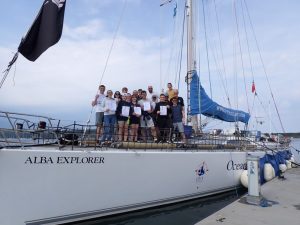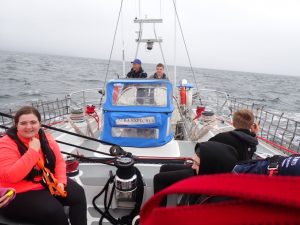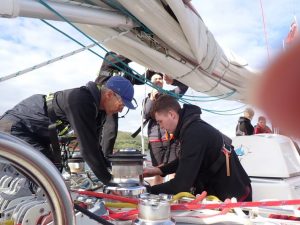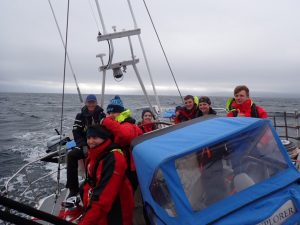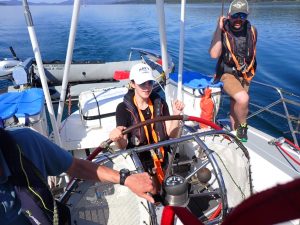HQ RAFAC/OYT Scotland West Coast Challenge
Offshore Sail Training Expedition
7th – 14th August 2022
Introduction
In August 2022 eleven Staff Cadets from across the UK took part in the 18th annual HQ RAFAC offshore sail training expedition hosted by Ocean Youth Trust Scotland. The below report has been produced by Cdt FS Georgia Greenwood on behalf of her fellow cadet crew.
Expedition Report
This report is an overview of our voyage onboard the Ocean Youth Trust Scotland sail training vessel, Alba Explorer, from the 7th August – 14th August 2022 and how we found this remarkable experience.
Monday 8th August
After traveling down from Glasgow together, we all boarded the Alba Explorer in Oban and picked our bunks, stowed our luggage, got issued our waterproofs and life jackets before getting briefed. Once briefed, it was time to jump straight into the sailing! Our first tasks were to set the sails (pulling and winching them up) and to collect all the fenders from around the side of the boat. Having left the harbour, we got shown the different parts of the boat which included: mast, helm, heads (toilets), galley, saloon, dry-room, cabins, forepeak, snake pit, cockpit, foredeck and the pig pen. We then sailed towards Salen (Isle of Mull) where we would anchor for the night.
In the evening, the OYT sea-staff told us that they couldn’t believe that we had only met each other the day before in Glasgow as we all seemed really close already and that we genuinely all got on well together.
Tuesday 9th August
The next morning was when we hauled up the anchor and maximised our efforts by chanting “two, six, heave” which we later discovered was an old sailing tradition as the crew would all have their own numbers which corresponded to their job. It was the job of two and six to haul in the anchor. Whilst sailing towards the Isle of Rhum, we split into two watches (each with a watch leader) and completed two-hour shifts at a time.
Whilst on watch we would take it in turns to helm (steer) which is where we also learnt to use the boat’s compass to keep the heading we needed and to be a look-out (watching for pot-buoys, other boats and anything else that could damage the boat). The others would be on standby to use the winches when needed. The waves were quite rough today and it was raining; making most people feel sea sick but everyone felt better when we anchored in Loch Scresort and went ashore to the Isle of Rhum via a dingy (some of us got the chance to motor the dingy) where we explored and found an otter hide, castle and looked into some environmental issues, such as plastic pollution, whilst picking up any litter that we saw.
The wind was quite strong overnight, so we were split up into pairs to do one and a half hour anchor-watches throughout the night monitoring the boat’s longitude, latitude, wind speed, depth of water, wind direction, if the anchor light was still on and if we were still within the ‘safety-box’, every fifteen minutes. To help keep us occupied we wrote a short story that everyone added to and it was read to everyone at breakfast.
Wednesday 10th August
The sea was a lot calmer today, so we hoisted the main sail and the jib. After hoisting the sails, we hauled in the anchor to set sail for Loch Maddie where there was a pontoon space waiting for us.
We completed our daily happy-hour (cleaning the boat above and below deck) before splitting off into our watches where we saw dolphins and porpoises along the way. Once we arrived at Loch Maddie, the Loch master welcomed us whilst we tidied the main sail and put the cover on as lots of people wanted to have a look around due to the size of our boat.
We managed to get showers whilst we were there, which everyone greatly enjoyed. In the evening, we all sat around the table in the saloon and started learning half of the knots needed to gain our competent crew certificate. These knots were: one round turn and two half hitches, bowline, figure-eight and clove hitch.
Thursday 11th August
We said our goodbyes to Loch Maddie and set sail for Vatersey. The waves were stronger than previous days as the wind was much stronger and it was raining; but it meant that we managed to sail at a speed of twelve knots with no motor.
We saw some more seals and dolphins along the way and had a talk about where we could go with the possibility of us doing a night sail if we wanted to. Everyone was very enthusiastic about it and wanted to give it a go. It wasn’t easy but we all got up at 1:00am and had two people at the bow of the boat with a search light looking for any pot buoys or obstructions.
The conditions were quite rough but overall, most people enjoyed it and were looking forward to getting to Gott Bay. Also, we got the chance to look at the boat’s engine whilst the Boson explained how it worked along with taking it in turns to fill in the boat’s logbook.
Friday 12th August
We arrived at Gott Bay early afternoon, but visibility was very low because it was very foggy. The Skipper promised us that there was a beach ahead, but we couldn’t see twenty metres ahead of us. Whilst waiting for the fog to lift, the first mate split us up into three teams to have a paddle race in the dingy around the boat (this also ticked off another part of the competent crew to-do list). By the time we had finished racing, the fog had cleared up enough to get ashore to the beach where we had some food and enjoyed basking in the sun. Heading back to the boat, we split back into our two watches to start our second night sail to Tobermory where there was a pontoon space for us to dock onto.
It was beautiful coming into Tobermory as it was all lit up and we had calm waters during our sail. We also witnessed a supermoon, Saturn, Mars, comets and a Minke whale. Beautiful.
Saturday 13th August
After twenty-three hours of sailing, we all were a bit tired but very excited to explore Tobermory and get another shower! Once back onboard by midday, we learnt the other four knots we needed to practice and they included: reef knot, rolling hitch, sheet bend and double sheet bend.
We then learnt about the different points of sail (most of which we had already experienced). They were: close hauled, close reach, beam reach, broad reach, training run and run. Learning which ones were the fastest or slowest points of sail.
We then all got a good night’s sleep before setting off in the morning back to Oban. Once we got to Oban and docked onto the pontoon, we hiked up to McCaig’s Tower where we watched the sun set and enjoyed our last night together in glorious weather.
Sunday 14th August
Our last day had arrived before we knew it and that meant it was time to do a massive boat clean up- both above and below deck. Everyone got stuck in and many hands made light work. We then all sat in the cockpit and reflected upon the voyage and got presented with our competent crew certificates. We all said our goodbyes and then left heading towards the train station to go our own separate ways back home…
Overall, the voyage was a tremendous experience that has left us with friends for life and new skills; something that we haven’t been able to do for the past two years due to Covid-19. It gave us the social interaction we had been missing for so long, together with learning how to sail, developing our teamwork, communication, time management and navigation skills that will prove to be valuable for the rest of our lives.
This was all made possible by very generous donations from the Royal Air Force Charitable Trust, the Ulysses Trust , the Singleton Trust and OYT Scotland.
We were also grateful for the hard work and dedication of the sea-staff: Peta (skipper), Lewis (first mate), Peter (watch leader), Alister (watch leader), Will (bosun), together with Flying Officer Tom Smith for watching over us for the week and Squadron Leader Mike Blakey for organising this incredible experience.
And for that we say a massive thank you for making it all possible.
The Ulysses Trust also wish to thank the generosity of the Royal Air Force Charitable Trust for supporting this expedition. www.rafct.com
Postscript:
By the end of the voyage the cadets had sailed a distance of 294nm including a total of 9 hours at night. Three cadets completed their Gold Duke of Edinburgh’s Award Residential and all eleven participants achieved their RYA Competent Crew Qualification. One keen individual has already returned to complete the OYT Scotland Bosun’s training course and is now set to join the West Coast Challenge voyage 2023 as a member of the sea-staff!
Submitted by: Sqn Ldr M.P.Blakey, MBE, RAFAC. HQ RAFAC

